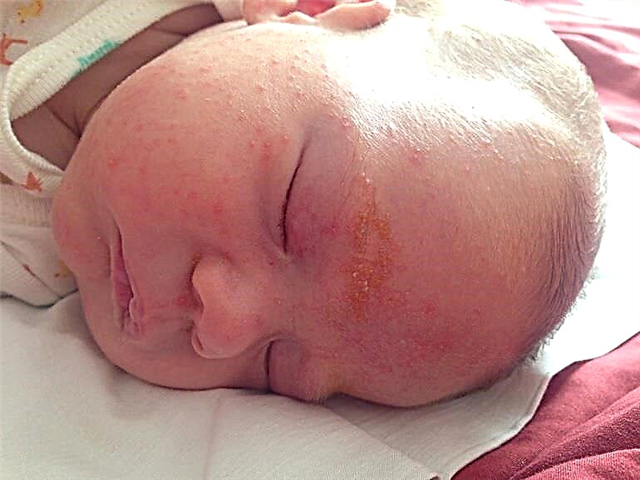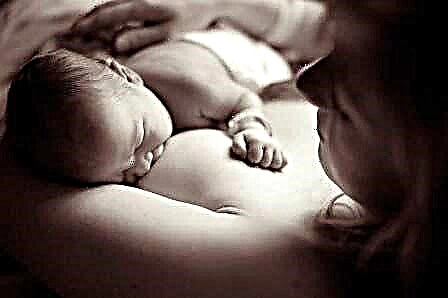Conjunctivitis is an inflammatory disease of the mucous membrane of the eye (conjunctiva) of an infectious and allergic nature. The mucous membrane (conjunctiva) lines the lower and upper eyelids and also covers the eyeball itself. It is a barrier that has a protective function.
This pathology ranks first among all inflammatory eye diseases in children under 5 years old, which can be explained by the imperfection of the immune system and non-compliance with the rules of personal hygiene.
Conjunctivitis in children is dangerous for its complications - keratitis, canaliculitis, dacryocystitis, which leads to decreased vision and irreversible changes.
Symptoms of the disease
Regardless of the cause of conjunctivitis, there are a number of common symptoms:
 swelling of the eyelids;
swelling of the eyelids;- redness (hyperemia) of the conjunctiva of one (less often) or both (more often) eyes;
- lacrimation;
- sensation of a foreign body (feeling of "sand in the eyes");
- blepharospasm;
- decreased visual acuity.
In young children, the disease can be suspected by analyzing their behavior. The child becomes restless, cries, tries to rub his eyes with his fists. If you look closely, then in the corners of the eyes you can see discharge or dried crusts.
Body temperature usually remains normal, with the exception of conjunctivitis that occurs with infectious diseases (bark, chickenpox), but in this case, the increase in temperature is explained by the presence of a general infectious process.
By the nature of the occurrence, the following forms of conjunctivitis are distinguished:
- viral,
- bacterial,
- fungal,
- allergic.
Viral conjunctivitis
Viral conjunctivitis is very often one of the symptoms of acute respiratory viral infections (influenza, adenovirus infection) or childhood infections transmitted by airborne droplets (measles, chickenpox).

Its appearance is always combined with the occurrence of a cold (rhinitis) or inflammatory diseases of the nasopharynx (pharyngitis).
In this case, viral conjunctivitis is not dangerous and, with timely treatment of the underlying disease, disappears within two to three days.
If no treatment is followed or the child's body has been weakened, a bacterial infection may join, which aggravates the course of the disease and leads to serious consequences.
The characteristic manifestations of viral conjunctivitis are pronounced blepharospasm, profuse mucous discharge and small-point hemorrhages in the thickness of the conjunctiva.
From the group of viral conjunctivitis, herpetic conjunctivitis is distinguished separately. The course of this disease is almost always very severe. The process involves the skin of the eyelids and the cornea.
And if the symptom complex, including severe itching, pain, foreign body sensation, blepharospasm, can still be confused with other types of conjunctivitis, then the presence of vesicles (vesicles) with serous contents both in the eyelids and in the conjunctiva itself will not doubt the correctness of the diagnosis.
Unlike all viral conjunctivitis, which is characterized by a two-sided process, herpetic conjunctivitis is characterized by the development of the disease in one eye. The difficulty in treating this pathology lies in the attachment of the bacterial flora with the formation of a mixed infection.
Bacterial conjunctivitis
Bacterial conjunctivitis is the most common form of conjunctivitis in children. The main reasons for their occurrence are microtraumas of the organ of vision and non-observance of hygiene rules. The disease is characterized by seasonality, it occurs mainly in the spring-autumn period.
Unlike viral conjunctivitis, bacterial ones are often accompanied by an increase in body temperature, an increase in headache and weakness, the appearance of enlarged and painful lymph nodes.
It should be remembered that in some cases conjunctivitis may occur not due to violations of the rules of personal hygiene or microtrauma of the conjunctiva (as, for example, when sand gets into the eyes), but due to changes in the eye's own microflora or the presence of a purulent-septic focus in the body (sinusitis, carious teeth, otitis media).
 In this case, the development of conjunctivitis should be considered as a generalized response of the body to the presence of infection.
In this case, the development of conjunctivitis should be considered as a generalized response of the body to the presence of infection.
The disease begins with damage to one eye, the second is involved in the process during the first three days. Discharge from the conjunctival cavity is purulent, viscous, the color varies from yellowish to yellow-green with veins.
There are many crusts on the eyelids, blepharospasm is significantly pronounced. The eyelids are swollen, blepharitis and keratitis may occur. If the body is weakened, dacryocystitis or lacrimal sac phlegmon may develop.
Among bacterial conjunctivitis, a separate place is occupied by gonococcal (gonoblenorrhea) and chlamydial conjunctivitis. Basically, newborns get sick with them.
For gonococcal, development is characteristic in the first 3 days of life, for chlamydia - during the first week of life.
Infection occurs when the child passes through the birth canal. The clinical picture is vivid: pronounced edema of the eyelids, the release of a large amount of serous-hemorrhagic discharge on the first day, which, in the process of progression, becomes purulent and acquires a greenish color. The conjunctiva is edematous, bleeds when touched.
This type of conjunctivitis almost always turns into keratoconjunctivitis with the development of corneal ulcers and a high possibility of perforation. The function and structure of the organ of vision is always affected. Subsequently, corneal opacity or leucorrhoea develops.
Fungal conjunctivitis
Fungal conjunctivitis is the most dangerous form, characterized by resistance to therapy and a tendency to progress.
For the development of fungal conjunctivitis, a prerequisite is either traumatic damage to the conjunctiva (very often parts of plants: stems, leaves, grains), or the child's immunodeficiency.
In the first case, the lesion is unilateral. In the second, both eyes are involved in the process.
The disease can be suspected by the threadlike discharge of a yellowish-gray color, the presence of polypoid formations or nodules on the conjunctiva, the lack of effect from the treatment, and the rather rapid involvement of all structures of the eyeball in the pathological process.
Allergic conjunctivitis
The most often susceptible to such conjunctivitis are children with a burdened allergic history (bronchial asthma, atopic dermatitis) or children with an immunodeficiency state.
 Development is always associated with the presence of food, medicinal, pollen and other allergens in an amount that can cause an allergic response. This type of conjunctivitis is the most favorable.
Development is always associated with the presence of food, medicinal, pollen and other allergens in an amount that can cause an allergic response. This type of conjunctivitis is the most favorable.
The manifestations of the disease decrease and completely disappear within 48 hours after the termination of contact with the allergen. However, do not forget that any type of conjunctivitis can hide behind the mask of an allergic one.
Diagnosis of the disease
To make a diagnosis, the following diagnostic methods are used:
- determination of visual acuity (visiometry);
- determination of visual fields (perimetry);
- inspection with a slit lamp (biomicroscopy);
- fundus examination (ophthalmoscopy).
Unlike adults, in children, an examination of the fundus is always carried out on a wide pupil;
- laboratory diagnostic methods.
After the examination, a bacteriological examination of a smear from the conjunctival cavity and sowing of the discharge from the conjunctiva on nutrient media is carried out. This must be done before starting treatment for the most reliable results.
Additional methods can be used: immunological and serological studies, intradermal tests. The manipulation is painless and usually well tolerated by children.
Prevention of conjunctivitis
Preventive measures are based on:
- teaching the child to observe the rules of personal hygiene;
- in-line disinfection of premises in child care facilities;
- increasing the body's immune forces.
Children with this disease are always isolated from their peers for the duration of the illness.
Prevention of conjunctivitis in newborns:
- responsible attitude of pregnant women to their health;
- carrying out urogynecological sanitation in the prenatal period;
- carrying out the treatment of the conjunctival cavity in newborns in the first hours after birth.
Conjunctivitis treatment
Conjunctivitis is not a disease that can be treated at home without compromising health. The correct and effective treatment of conjunctivitis can only be prescribed by an ophthalmologist.

Self-medication and instillation of antibacterial, anti-inflammatory drops makes it impossible to establish the cause and the selection of effective therapy, and is also often the cause of complications.
The use of compresses, tinctures, decoctions can lead to a significant deterioration in the condition of the eyes, up to the loss of function or the organ of vision itself.
The basis for the treatment of conjunctivitis is local treatment - the use of eye drops and ointments.
Advice! Each eye is treated with a separate cotton or gauze swab in the direction from the outer corner to the inner corner, the frequency of instillation is 6 - 8 times a day.
Viral conjunctivitis
- the treatment is based on the appointment of eye drops with recombinant interferon type alpha-2 (Oftalmoferon). The appointment is justified in the first few days of the disease, when the concentration of viral agents in the conjunctival cavity is high;
- to relieve symptoms of viral conjunctivitis in complex treatment, artificial tear preparations are used;
- when a secondary bacterial infection is attached, antibacterial drops (fluoroquinolones, aminoglycosides) are prescribed. Aminoglycosides (Tobrex) can be used in children from birth, while fluoroquinolones (Floxal, Oftaquix) are recommended for use when a child reaches the age of 7 years;
- with herpetic conjunctivitis, drugs containing acyclovir are prescribed. Locally - in the form of ointments, in general treatment - in the form of tablets.
Bacterial conjunctivitis
- antibacterial drops (fluoroquinolones, aminoglycosides) are prescribed.
Aminoglycosides can be prescribed to children from birth, while other antibacterial drugs are recommended to be prescribed from the age of 7 years;
- to relieve symptoms in complex treatment, artificial tear preparations are used.
Fungal conjunctivitis
In general treatment, antifungal drugs are necessarily used. Unfortunately, there are no topical forms of antifungal drugs. In the absence of success, surgical treatment may be necessary associated with the removal of the affected areas of the conjunctiva.
Allergic conjunctivitis
- the main thing in the treatment is the identification of the allergen and, if possible, its elimination;
- artificial tear preparations are used as remedies for symptoms;
- the use of antihistamines, steroid and non-steroidal anti-inflammatory drugs is considered on a case-by-case basis.
When complications appear in the form of keratitis, dacryocystitis or phlegmon of the lacrimal sac, the child is hospitalized in a hospital.

 swelling of the eyelids;
swelling of the eyelids;

